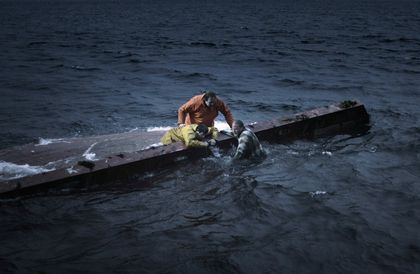
Einar went to the movies: Djúpið
Finally got around to see Baltasar Kormákur’s film Djúpið (‘The Deep’) the other day. This film is mainly inspired by events by the Westman Islands in 1984, when fisherman Guðlaugur Friðþórsson managed to safe his life as his boat Hellisey went down, by swimming a distance of about six kilometers to Heimaey island, with the sea temperature about 6 degrees Celsius. This was an astonishing and unprecedented feat.
Guðlaugur was the sole survivor, four of his friends perished.
Guðlaugur, though having previously been interviewed about the event and lent his support to a documentary about it, wasn’t happy about the film being made, claiming he never gave his consent, while Baltasar maintains that he was under the impression that he had Guðlaugur’s consent.
In a way, one can understand both. It is very understandable that Guðlaugur may feel that the events are still to recent, the pain still too fresh, having lost his friends, that this was a very real and painful experience for him that has left its scars.
At the same time, it is highly understandable that this story should be intriguing and that a director would want to tell it and at the same time pay homage to the plight of the Icelandic sailors and their families.
Having seen the film I can definitely say that Guðlaugur needn’t have worried about Baltasar not treating the subject matter wih respect. It is indeed a sensitive issue and it is all too easy and common for such films to decend into ‘emotional porn’, into sensationalism and kitch. I am happy to say that the film manages to avoid these traps and instead delivers a subtle , yet strong human tale, that by its very approach manages to be all the more effective.
The cinematography of the film is truly excellent, you get the feel both for nature’s beauty and it’s harshness, it’s bleakness even, or cold indifference, and it never feels forced. You never get the ‘oh look NATUUUURRRRE, LOOKY LOOKY HERE *violins*- feel, all too common. You don’t even see particularly strong waves, simply because there was no storm that night. Mainly this was an extraordinary long swim in the cold North Atlantic Ocean. A scene where main actor Ólafur Darri is in the sea and the camera pulls back more and more really gives you an idea of the vastness of the sea, and him there, swimming alone, the sole survivor.
During the swim/half drowning the main character has flashbacks, and scenes from the volcanic eruption of Heimaey in 1973 are used particularly effectively.
Another strong point of the movie is the aftermath. The main character dealing with new-found fame and the loss of his friends and the families dealing with the loss of these same crewmembers. This loss and the hope and prayers of the families, awake strong empathy, this is such a strong part of Iceland’s continuing history, it’s like a whole world story is contained in this hope: ‘Let them return safely’.
Scenes like the one where the main character is conversing with the seagulls (or monologuing, if you will) would have seemed like a dramatic licence, but in the closing of the film we actually see the real Guðlaugur describing some of his feelings during the swim and there he mentions the conversation with the gulls, a way of passing time.
The performances in the film are strong, but special mention must go to Ólafur Darri Ólafsson in the main role. Besides bearing an uncanny resemblance to Guðlaugur, he gives an extraordinary strong and subtle performance, and proves once again that he is one of Iceland’s very best actors. The fact that special effects weren’t used for the swimming, That Ólafur really WAS swimming in a cold sea, (though, thankfully, not for about 6 km like Guðlaugur), as perhaps best seen in the aforementioned pullback scene, is no less impressive.
Baltasar Kormákur dedicated Djúpið to the Icelandic sailor and with this film he has managed to create a beautiful and deeply moving tribute. If you have the chance of seeing the film in cinema, I’d recommend that for the best experience. Otherwise look for the DVD. I’d also highly recommend visiting the Westman Islands and I would be happy to direct you to good tours available.
其他有意思的博客
冰岛最浪漫的角落
对于很多人,遥远的冰岛有着世界尽头的神秘,有着区别于巴黎、马尔代夫、自成一体的浪漫。没有埃菲尔铁塔和蒂凡尼,没有热带沙滩,而是在冰川、火山、苔藓地的背景下蜜月旅拍、婚拍,甚至举办一场冰岛婚礼。来冰岛旅行,多是要跨千山万水、飞跃大洋大陆,很有一点“万水千山陪你走过”的史诗感。难怪很多人说,光是冰岛二字,就足够浪漫了。 冰岛虽然不大,但是地貌极其丰富,不同的自然景观自然有不同的气质。这一篇,就挑阅读更多从极光观测到摄影-到底该不该来冰岛看极光
很多朋友都想来冰岛看极光,但是冰岛到底适不适合看极光呢?几月、什么季节能看到极光?是不是一定要参加北极光旅行团?如何能拍摄出美丽的极光照片呢?在冰岛住了好几年了,从刚开始逢极光必出门,到如今家里阳台就能看极光,我对在冰岛看极光的了解和经验,也算得上大半个专家了,且听我娓娓道来吧。 到底该不该来冰岛看极光呢?最坦诚的答案是,不要只为了看极光而看极光。 极光原理 太阳活动→太阅读更多
迷失冰岛的米湖游览推荐|不只有温泉的地热宝藏区
我在冬夏秋均到访过米湖,看过米湖的不同面。一直以来,米湖到底值不值得去是很多游客争论的问题。有些人觉得这里是来冰岛旅行的必去目的地,有些人则说米湖“太丑了”,连照片都不想多拍几张。那米湖到底值不值得来呢?到底怎么玩呢? 米湖的风景 北部的米湖,因地理位置相距首都雷克雅未克略远,很多来冰岛的短途游客选择放弃,其实米湖应该是和黄金圈、南岸沿线至冰湖齐名的冰岛景色,这里冷热相融,可谓最冰岛,尤其阅读更多

将冰岛最大的旅行平台下载到您的手机中,一站式管理您的整个行程
使用手机摄像头扫描此二维码,然后点击显示的链接,将冰岛最大的旅行平台添加到您的手机中。输入您的电话号码或电子邮件地址,以接收包含下载链接的短信或电子邮件。



















